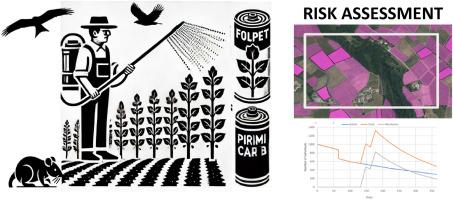陆生脊椎动物农药风险评估中包含农学和生态学特征的基于景观的简化方法
IF 7.3
2区 环境科学与生态学
Q1 ENVIRONMENTAL SCIENCES
引用次数: 0
摘要
农药在提高粮食生产方面发挥了至关重要的作用,尽管它们的大量使用对生态系统构成重大威胁,并可能对非目标生物造成有害影响,而目前的风险评估方法往往无法充分解决这些问题。本研究引入了一种新的方法,将来自监管报告的数据与荟萃分析相结合,得出与人群相关参数的剂量-反应曲线。然后将这些曲线整合到一个简化的种群动态模型中,以估计综合农药暴露对地中海农业景观中陆生脊椎动物的潜在种群水平影响,重点是法国博若莱的葡萄园,这是一个受地中海影响的半大陆地区。该模型已被应用于农药folpet和吡虫威的概念验证,以估计与预期对繁殖率和存活率的影响有关的人口下降。研究发现,福尔佩特对哺乳动物种群的影响更为严重,而吡立威主要影响鸟类。此外,农药施用的时机至关重要,与季末处理相比,季前施用吡乐威导致的降幅更高。此外,两种农药的联合使用所产生的影响是单一农药评估无法捕捉到的。该研究强调了景观评估在综合实际农业条件下农药施用时间表的影响方面的好处,并为评估风险缓解方法提供了机会。尽管该模型被简化了,而且存在一定的局限性,但研究结果证实了利用监管农药风险评估提供的信息评估连续施用农药的综合效应的可能性。这项研究呼吁继续进行研究,以更好地了解和减轻与农药使用有关的环境风险。本文章由计算机程序翻译,如有差异,请以英文原文为准。


A simplified landscape-based approach for including agronomical and ecological characteristic in pesticide risk assessments for terrestrial vertebrates
Pesticides have played a crucial role in enhancing food production, although their intensive application poses significant threats to ecosystems and may cause harmful effects on non-target organisms, which are often inadequately addressed by current risk assessment methods. This study introduces a novel approach by combining data from regulatory reports with a meta-analysis to derive dose-response curves for population-relevant parameters. These curves are then integrated into a simplified population dynamics model to estimate the potential population-level effects of combined pesticide exposure on terrestrial vertebrates in Mediterranean agricultural landscapes, with a focus on vineyards in Beaujolais, France, a semi-continental region with Mediterranean influence. The model has been applied as a proof of concept to the pesticides folpet and pirimicarb, estimating the population declines linked to the expected effects on reproductive and survival rates. Folpet was found to have a more severe impact on mammal populations, while pirimicarb primarily affected birds. Additionally, the timing of pesticide application was crucial, with early-season applications of pirimicarb resulting in higher declines compared to late-season treatments. Moreover, the combined use of both pesticides resulted in effects that were not captured by single-pesticide assessments. The study highlights the benefits of landscape assessments for integrating the impacts of pesticide application schedules in real farming conditions, and offers opportunities for assessing risk mitigation approaches. Although the model is simplified and subject to certain limitations, the findings confirm the possibility for assessing the combined effects of successive applications using the information available from regulatory pesticide risk assessments. This study calls for continued research to better understand and mitigate the environmental risks associated with pesticide use.
求助全文
通过发布文献求助,成功后即可免费获取论文全文。
去求助
来源期刊

Environmental Pollution
环境科学-环境科学
CiteScore
16.00
自引率
6.70%
发文量
2082
审稿时长
2.9 months
期刊介绍:
Environmental Pollution is an international peer-reviewed journal that publishes high-quality research papers and review articles covering all aspects of environmental pollution and its impacts on ecosystems and human health.
Subject areas include, but are not limited to:
• Sources and occurrences of pollutants that are clearly defined and measured in environmental compartments, food and food-related items, and human bodies;
• Interlinks between contaminant exposure and biological, ecological, and human health effects, including those of climate change;
• Contaminants of emerging concerns (including but not limited to antibiotic resistant microorganisms or genes, microplastics/nanoplastics, electronic wastes, light, and noise) and/or their biological, ecological, or human health effects;
• Laboratory and field studies on the remediation/mitigation of environmental pollution via new techniques and with clear links to biological, ecological, or human health effects;
• Modeling of pollution processes, patterns, or trends that is of clear environmental and/or human health interest;
• New techniques that measure and examine environmental occurrences, transport, behavior, and effects of pollutants within the environment or the laboratory, provided that they can be clearly used to address problems within regional or global environmental compartments.
 求助内容:
求助内容: 应助结果提醒方式:
应助结果提醒方式:


